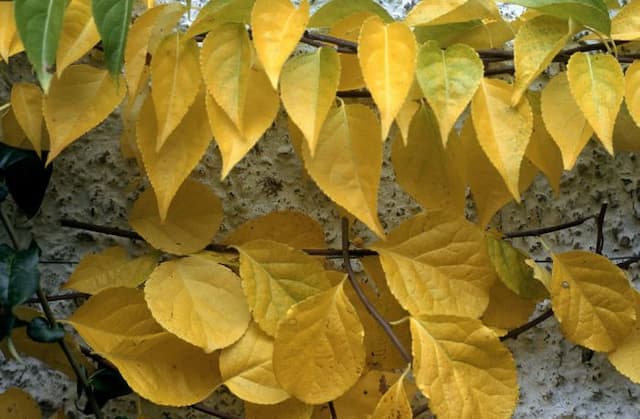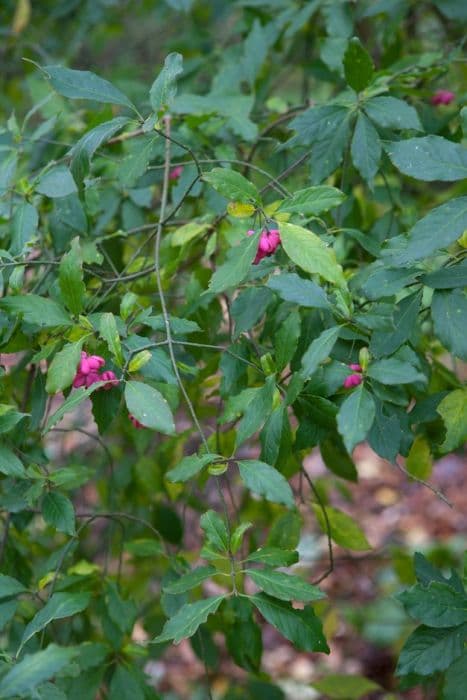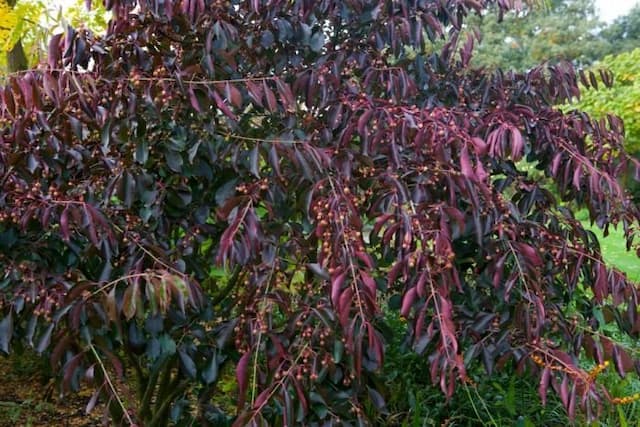Wintercreeper Euonymus fortunei Dan's Delight = 'Dandel' (PBR) (v)
ABOUT
Euonymus fortunei Dan's Delight, commonly known as Wintercreeper, is a visually appealing variety characterized by its vibrant foliage. The leaves of this plant are glossy and exhibit a variegated pattern, displaying shades of green with creamy white to yellow margins that tend to create an eye-catching contrast. This distinctive patterning can make the Wintercreeper a striking addition to any garden. Throughout the year, the hues of the leaves may intensify, providing seasonal interest and maintaining the ornamental quality of the plant even when not in bloom. This particular variety of Wintercreeper is also known for its growth habit, forming a dense and bushy presence in the landscape. Its stems can have a tendency to climb if given support, thus adding another dimension of visual interest through its spreading nature. The texture of the plant is also notable, with the leaf surfaces being slightly leathery to the touch. Flowers may be present but are typically small and inconspicuous, taking a backseat to the striking foliage that is the main draw of the Wintercreeper Dan's Delight. As a cultivated variety marked with (PBR), this indicates that the plant has been granted Plant Breeders' Rights, reflecting its unique characteristics and cultivated status. Overall, the graphic variegation and lush appearance make the Wintercreeper Dan's Delight a popular choice for gardeners seeking to add vibrant, year-round interest to their outdoor spaces without necessarily focusing on floral displays.
About this plant
 Names
NamesFamily
Celastraceae
Synonyms
Wintercreeper, Fortune's Spindle, Winter Euonymus
Common names
Euonymus fortunei 'Dandel'
 Toxicity
ToxicityTo humans
Wintercreeper is considered to be mildly toxic if ingested by humans. The consequences of consuming parts of the plant can result in symptoms such as nausea, vomiting, abdominal pain, diarrhea, and weakness. It is recommended to seek medical attention if any parts of the plant are accidentally consumed, especially in case of large quantities.
To pets
Wintercreeper can also be toxic to pets if ingested. Symptoms of poisoning may include vomiting, diarrhea, abdominal pain, and possibly weakness or heart issues, depending on the amount consumed. Pets showing signs of wintercreeper poisoning should be taken to a veterinarian for treatment as soon as possible.
 Characteristics
CharacteristicsLife cycle
Perennials
Foliage type
Evergreen
Color of leaves
Variegated
Height
2 feet (0.61 meters)
Spread
4 feet (1.22 meters)
Plant type
Shrub
Hardiness zones
5-9
Native area
Eastern Asia
Benefits
 General Benefits
General Benefits- Low Maintenance: Euonymus fortunei 'Dan's Delight' requires minimal upkeep once established, making it an ideal choice for gardeners of all levels.
- Drought Tolerant: Once established, it can withstand periods of dry weather, reducing the need for frequent watering.
- Versatile Landscaping: This plant can be used in a variety of landscaping situations, including ground cover, borders, or as a climbing vine.
- Evergreen Foliage: It retains its leaves throughout the seasons, providing year-round interest and coverage in the garden.
- Variegated Leaves: The distinctive cream and green variegated leaves add visual interest and contrast against other plants.
- Hardy: It is capable of surviving in a range of climates and is resistant to many common pests and diseases.
- Compact Size: It is suitable for smaller gardens or spaces where control over plant size is desired.
- Easy to Propagate: It can be easily propagated from cuttings, making it simple to produce more plants.
- Attracts Wildlife: It provides shelter and food for birds and insects, supporting local biodiversity.
 Medical Properties
Medical PropertiesThis plant is not used for medical purposes.
 Air-purifying Qualities
Air-purifying QualitiesThis plant is not specifically known for air purifying qualities.
 Other Uses
Other Uses- Winter Garden Interest: The variegated leaves of Wintercreeper can provide visual interest to a winter garden when most other plants have died back or lost their color.
- Natural Fabric Dyes: The leaves and stems can be used to produce natural dyes for fabric, giving a range of hues from yellows to browns depending on processing methods.
- Bonsai: Wintercreeper can be trained as a bonsai plant, for those who appreciate the art of miniaturized trees and enjoy the detailed care that bonsai requires.
- Education Tools: In botany education, Wintercreeper is used to help students learn about plant propagation techniques like cuttings and layering due to its ease of growth.
- Erosion Control: Wintercreeper can be planted on slopes or areas prone to erosion to help stabilize soil with its root system.
- Privacy Screens: Grown on trellises or fences, Wintercreeper can act as a living privacy screen in areas where traditional fencing is either impractical or undesirable.
- Topiary: With regular trimming, Wintercreeper can be shaped into topiary forms, offering a creative outlet for gardeners and landscapers.
- Photography: Its dense foliage and variegation makes it an interesting subject for nature photographers, especially when capturing the texture and patterns of plants.
- Maze Creation: For gardeners interested in creating garden mazes or labyrinths, Wintercreeper can be a good choice due to its dense growing habit and ability to be shaped by pruning.
- Refuge for Wildlife: Because it can create dense thickets, it provides hiding spots and shelter for small wildlife like birds and beneficial insects.
Interesting Facts
 Feng Shui
Feng ShuiThe wintercreeper is not used in Feng Shui practice.
 Zodiac Sign Compitability
Zodiac Sign CompitabilityThe wintercreeper is not used in astrology practice.
 Plant Symbolism
Plant Symbolism- Endurance: Euonymus fortunei is known for its hardiness and ability to thrive in various conditions, symbolizing the resilience to endure life’s challenges.
- Adaptability: The plant's versatile nature in landscape use reflects the trait of adaptability, suggesting one’s ability to prosper in diverse environments.
- Longevity: As an evergreen, it represents long life and lasting presence.
- Protection: Often used as a hedge, it symbolizes creating boundaries and providing protection.
- Prosperity: Its vigorous growth and lush foliage can signify growth and the pursuit of prosperity in one’s life.
 Water
WaterThe Wintercreeper should be watered thoroughly, allowing the top inch of soil to dry out between waterings. In moderate climates, this may be once a week, but during hotter periods, it could require watering two to three times a week. It is best to provide enough water to reach the root depth each time, which might be around 1 to 2 gallons for an established plant, depending on its size. Frequency should decrease during the fall and winter when the plant's water needs lessen. Overwatering can lead to root rot, so it is essential to ensure good drainage and prevent water from standing around the plant's base.
 Light
LightThe Wintercreeper thrives in partial to full shade light conditions, making it a versatile choice for various garden locations. However, the ideal spot for this plant would provide morning sun followed by afternoon shade, or dappled sunlight throughout the day. Avoid placing it in prolonged full sun, which can scorch its leaves, or deep full shade where its growth may be stunted.
 Temperature
TemperatureWintercreeper is hardy and can tolerate a range of temperatures, but it grows best when the temperature is between 60°F and 80°F. It can survive in temperatures as low as -30°F and as high as 90°F, but extreme temperatures may damage the plant or slow its growth. Slight temperature changes within this range will not harm the plant, making it suitable for various climates.
 Pruning
PruningPruning the Wintercreeper is necessary to maintain its shape and encourage bushier growth. It's best to prune in late winter or early spring before new growth begins. Periodically trim throughout the growing season to keep the plant tidy, focusing on removing any dead or damaged branches. Extensive pruning should be avoided during the summer and fall as it can leave the plant vulnerable to damage in the winter.
 Cleaning
CleaningAs needed
 Soil
SoilWintercreeper prefers well-drained soil with a mix of loam, sand, and organic matter. The best soil mix for Euonymus fortunei 'Dan's Delight' consists of two parts garden soil, one part sand, and one part compost or peat moss to maintain aeration and moisture retention. The ideal pH for this plant ranges from 6.0 to 7.5, ensuring a slightly acidic to neutral soil environment for optimal growth.
 Repotting
RepottingWintercreeper doesn't require frequent repotting and can typically be repotted every 2-3 years. However, younger or faster-growing plants may need repotting once a year to ensure they have enough space to grow. Check the root system in spring and repot if the roots are starting to circle the pot or come out of the drainage holes.
 Humidity & Misting
Humidity & MistingWintercreeper is tolerant of a wide range of humidity levels and can thrive in the average humidity found in most homes or gardens. There is no specific humidity requirement for this plant as long as soil moisture levels are appropriately maintained with regular watering.
 Suitable locations
Suitable locationsIndoor
Place in bright, indirect light; water when topsoil is dry.
Outdoor
Plant in sun or partial shade; well-draining soil.
Hardiness zone
5-9 USDA
 Life cycle
Life cycleWintercreeper, 'Dan's Delight' (Euonymus fortunei 'Dandel') starts its life cycle as a seed or more commonly from cuttings since patented cultivars are often vegetatively propagated. Upon planting, it enters a growth phase where it develops a root system and foliage, becoming a young plant. As it matures, it becomes an evergreen groundcover or climbing vine, depending on its support, with dense leaves that can variegate in color. Wintercreeper blooms with small, inconspicuous flowers in the summer followed by fruit set if pollination occurs, although decorative appeal is mainly in its foliage. It reaches maturity in a few years, where it maintains its size and shape with periodic growth of leaves and stems. This plant's life cycle continues with new vegetative growth each year, and without significant frost damage or disease, it can live for several years, continuing to produce new foliage and potentially seeds or cuttings for propagation.
 Propogation
PropogationPropogation time
Spring to Early Summer
For the Wintercreeper 'Dan's Delight', also known by its botanical name Euonymus fortunei 'Dandel', the most popular method of propagation is through semi-hardwood cuttings. This technique is best performed during the summer months, when the plant's growth is vigorous yet the current year's stems have begun to mature and harden slightly. The process involves selecting healthy, disease-free stems and making cuttings approximately 4 to 6 inches (10 to 15 centimeters) in length, cutting just below a leaf node. Leaves on the lower half of the cutting are removed to prevent excess moisture loss and the base of the cutting is often dipped in a rooting hormone to promote root development. The prepared cuttings are then inserted into a well-draining potting mix and kept in a warm, humid environment with indirect light until roots have formed, which typically takes several weeks.







